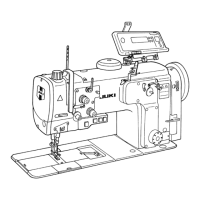-
27
-
29. TROUBLES IN SEWING AND CORRECTIVE MEASURES
Troubles Causes Corrective measures
1. Thread breakage
(Thread frays or is worn
out.)
(Needle thread trails 2 to
3 cm from the wrong side
of the fabric.)
Thread path, needle point, hook blade point or
bobbin case resting groove on the throat plate has
sharp edges or burrs.
Needle thread tension is too high.
Bobbin case opening lever provides an excessive
clearance at the bobbin case.
Needle comes in contact with the blade point of
hook.
Amount of oil in the hook is too small.
Needle thread tension is too low.
Thread take-up spring works excessively or the
stroke of the spring is too small.
Timing between the needle and the hook is exces-
sively advanced or retarded.
Remove the sharp edges or burrs on the blade
point of hook using a fine emery paper. Buff up
the bobbin case resting groove on the throat plate.
Decrease the needle thread tension.
Decrease the clearance provided between the
bobbin case opening lever and the bobbin. Refer
to “22. ADJUSTING THE BOBBIN CASE OPEN-
ING LEVER.”
Refer to “20. NEEDLE-TO-HOOK RELATION.”
Adjust the amount of oil in the hook properly. See
“13. ADJUSTING THE AMOUNT OF OIL IN THE
HOOK.”
Increase the needle thread tension.
Decrease the tension of the spring and increase
the stroke of the spring.
Refer to “20. NEEDLE-TO-HOOK RELATION.”
2. Stitch skipping
Timing between the needle and the hook is exces-
sively advanced or retarded.
Pressure of the presser foot is too low.
The clearance provided between the top end of
the needle eyelet and the blade point of hook is
not correct.
Hook needle guard is not functional.
Improper type of needle is used
Refer to “20. NEEDLE-TO-HOOK RELATION.”
Tighten the presser spring regulator.
Refer to “20. NEEDLE-TO-HOOK RELATION.”
Refer to “21. ADJUSTING THE HOOK NEEDLE
GUARD.”
Replace the needle with one which is thicker than
the current needle by one count.
3. Loose stitches
Bobbin thread does not pass through the tension
spring of the inner hook.
Threadpathhasbeenpoorlynished.
Bobbin fails to move smoothly.
Bobbin case opening lever provides too much
clearance at the bobbin.
Bobbin thread tension is too low.
Bobbin has been wound too tightly.
Thread the bobbin thread correctly.
Removeroughpartswithaneemerypaperor
buff it up.
Replace the bobbin or hook with a new one.
Refer to “22. ADJUSTING THE BOBBIN CASE
OPENING LEVER.”
Increase the bobbin thread tension.
Decrease the tension applied to the bobbin wind-
er.
4. Thread slips off the needle
eyelet simultaneously with
thread trimming.
Thread tension given by the tension controller No.
1 is too high.
Decrease the thread tension given by the tension
controller No. 1.
5. Thread slips off the needle
eyelet at the start of sew-
ing.
Thread tension given by the tension controller No.
1 is too high.
Clamp spring has improper shape.
Bobbin thread tension is too low.
Decrease the thread tension given by the tension
controller No. 1.
Replace the clamp spring with a new one or
correct the current one.
Increase the bobbin thread tension.
6. Thread is not cut sharply.
The blades of moving knife and counter knife have
been improperly adjusted.
The knives have blunt blades.
Bobbin thread tension is too low.
Refer to “23. POSITION OF THE COUNTER
KNIFE AND ADJUSTMENT OF THE KNIFE
PRESSURE.”
Replace the moving knife and counter knife with
new ones, or correct the current ones.
Increase the bobbin thread tension.
7. Thread remains uncut
after thread trimming.
(Bobbin thread trimming
failure when stitch length
is comparatively short.)
Initial position of the moving knife has been im-
properly adjusted.
Bobbin thread tension is too low.
Refer to “Adjusting the initial position of the knife”
in the Engineer’s Manual.
Increase the bobbin thread tension.
8. Thread breaks at the start
of sewing after thread
trimming.
The needle thread is caught in the hook. Shorten the length of thread remaining on the nee-
dle after thread trimming. Refer to “16. THREAD
TENSION.”

